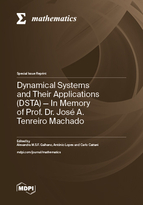Dynamical Systems and Their Applications (DSTA) — In Memory of Prof. Dr. José A. Tenreiro Machado
A special issue of Mathematics (ISSN 2227-7390). This special issue belongs to the section "C2: Dynamical Systems".
Deadline for manuscript submissions: closed (31 March 2023) | Viewed by 42911
Special Issue Editors
Interests: systems modelling; dynamics; multidimensional scaling; fractional calculus
Special Issues, Collections and Topics in MDPI journals
Interests: complex systems modelling; automation and robotics; fractional order systems modelling and control; data analysis and visualization; machine learning
Special Issues, Collections and Topics in MDPI journals
Interests: computational methods; mathematical physics; nonlinear systems
Special Issues, Collections and Topics in MDPI journals
Special Issue Information
In Memory of Prof. J. A. Tenreiro Machado
On October 6, 2021 Prof. Tenreiro Machado passed away. With his kindness, his warm character and his sophisticated sense of humor, Prof. Tenreiro Machado had a reassuring presence, which helped the flow of exchanges at all levels. His passion for science seemed to be boundless. He was always eager to embark on new projects and to contaminate others with his enthusiasm.
Prof. Tenreiro Machado had a great cultural background and very extensive scientific interests. He was a pioneer in the field of fractional calculus. The breadth of Prof. Tenreiro Machado’s research, the global dissemination of his results, and his legacy belong to all scholars involved in any way in the study of fractional calculus.
His innovative mathematical ideas and contributions will certainly serve as an inspiration for mathematicians for a long time.
We are proud that he was the Editor-in-Chief of Mathematics and Section Editor-in-Chief of Entropy when this Special Issue was proposed. We dedicate this Special Issue to his memory. We are unable to express our sadness for this loss.
Dear Colleagues,
The theory of dynamical systems has evolved from linear to nonlinear and then to complex systems. Indeed, new modelling and control techniques have been developed and applied in various fields, such as physics, mechanics, electronics, economy, finance, geophysics and biology to mention a few. Nonlinear and complex dynamical systems, as well as their related concepts of chaos, bifurcations, criticality, symmetry, memory, scale invariance, fractality, fractionality and other rich features, have attracted researchers from many areas of science and technology that are involved in systems modelling and control, with applications to real-world problems. However, at present, there are still many unsolved problems, and new theoretical developments and applications are needed in order to describe and control more accurately dynamical systems with linear, nonlinear and complex behaviour.
This Special Issue focuses on the modelling and control of dynamic systems. Manuscripts on linear and nonlinear dynamics, systems modelling, advanced control theory, complex systems, fractional calculus, fractals, entropy, information theory, chaos, self-organization and criticality, among others, are welcome.
This Special Issue will bring together contributions from researchers in different topics of engineering, mathematics, physics, biology, geophysics and other sciences. Papers describing original theoretical research as well as new experimental results are welcome.
You may choose our Joint Special Issue in Entropy.
Prof. Dr. Alexandra M.S.F. Galhano
Prof. Dr. António Lopes
Prof. Dr. Carlo Cattani
Guest Editors
Manuscript Submission Information
Manuscripts should be submitted online at www.mdpi.com by registering and logging in to this website. Once you are registered, click here to go to the submission form. Manuscripts can be submitted until the deadline. All submissions that pass pre-check are peer-reviewed. Accepted papers will be published continuously in the journal (as soon as accepted) and will be listed together on the special issue website. Research articles, review articles as well as short communications are invited. For planned papers, a title and short abstract (about 100 words) can be sent to the Editorial Office for announcement on this website.
Submitted manuscripts should not have been published previously, nor be under consideration for publication elsewhere (except conference proceedings papers). All manuscripts are thoroughly refereed through a single-blind peer-review process. A guide for authors and other relevant information for submission of manuscripts is available on the Instructions for Authors page. Mathematics is an international peer-reviewed open access semimonthly journal published by MDPI.
Please visit the Instructions for Authors page before submitting a manuscript. The Article Processing Charge (APC) for publication in this open access journal is 2600 CHF (Swiss Francs). Submitted papers should be well formatted and use good English. Authors may use MDPI's English editing service prior to publication or during author revisions.
Keywords
- complex systems
- linear and nonlinear dynamics
- advanced control theory
- fractional calculus
- fractals
- entropy
- information theory
Benefits of Publishing in a Special Issue
- Ease of navigation: Grouping papers by topic helps scholars navigate broad scope journals more efficiently.
- Greater discoverability: Special Issues support the reach and impact of scientific research. Articles in Special Issues are more discoverable and cited more frequently.
- Expansion of research network: Special Issues facilitate connections among authors, fostering scientific collaborations.
- External promotion: Articles in Special Issues are often promoted through the journal's social media, increasing their visibility.
- Reprint: MDPI Books provides the opportunity to republish successful Special Issues in book format, both online and in print.
Further information on MDPI's Special Issue policies can be found here.








